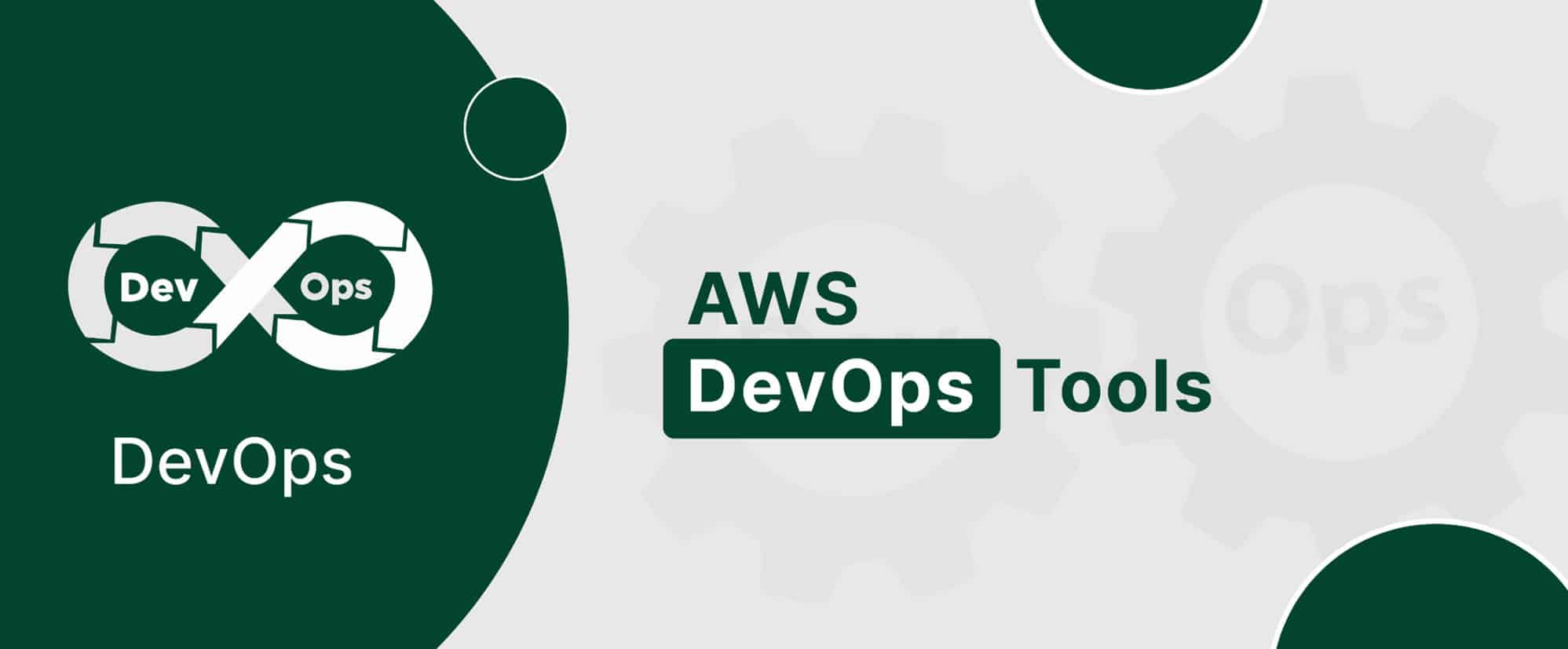Top 10 Essential AWS DevOps Tools Explained

Whether you’re looking to automate tasks, boost efficiency, or improve collaboration, these AWS DevOps tools are your go-to for a smooth development process. Let’s explore how they can make your life easier!
According to CLOUDZERO, 25% of teams integrate DevOps tools into one platform to reduce complexity.
DevOps techniques see a 60% reduction in operational failure and a 55% reduction in time to market for new features and applications.
Why are organizations leaning toward DevOps tools?
The answer is obvious. The DevOps tools accomplish the following tasks:
- DevOps tools automate manual tasks.
- They manage intricate deployments beautifully.
- They enhance overall efficiency in production and operations.
Moreover, the benefits come with DevOps tools, such as:
- DevOps tools boost speed and efficiency.
- DevOps tools promote collaboration among the team throughout the product life cycle.
- DevOps tools enhance reliability and scalability.
- The tools are cost-effective.
- They offer enhanced security.
AWS (Amazon Web Services) offers a couple of DevOps tools and services, and today’s post illustrates them with the required details. Let’s see.
First, let me give an outline of the AWS tool categories:
AWS Continuous Integration and Deployment (CI/CD) Tools:
- AWS CodePipeline
- AWS CodeBuild
- AWS CodeDeploy
- AWS CodeStar
- AWS Device Farm
- AWS Cloud Development Kit
AWS Microservices:
- Amazon Elastic Container Service
- Amazon Elastic Kubernetes Service
- Amazon Elastic Container Registry
- AWS Faregate
- AWS Lambda
Infrastructure as a Code:
- AWS CloudFormation
- AWS OpsWorks
- AWS System Manager
- AWS Config
Monitoring:
- Amazon CloudWatch
- AWS X-Ray
- AWS CloudTrail
With this understanding, let’s check a few essential or leading AWS DevOps tools.
AWS DevOps Tool#1 – AWS CodePipeline:
What Is It?
It’s an automation tool/service to automate the process of releasing and deployment of the pipeline for fast and reliable application and infrastructure updates. It integrates with other AWS services, such as CodeCommit, CodeBuild, and CodeDeploy. Its prime function is to offer a seamless workflow from code changes to production deployment. So you can confidentially roll out new features and updates. Thus, it is an integral part of toolkits for DevOps.
Where Will You Use It?
- It offers CI/CD (continuous integration and delivery) for your software.
- It can manage multiple environments.
- It manages multi-region deployments.
- It integrates with multiple source code repositories.
- It supports custom actions to extend the pipeline.
AWS DevOps Tool#2 – AWS CodeBuild:
What Is It?
It’s a fully managed build service. It compiles source code, runs unit tests, and produces ready-to-use artifacts. It supports a wide range of programming languages, build tools, and OS.
Where Will You Use It?
- It’s an excellent CI (continuous integration) service to build and test code changes whenever code is pushed to the repository.
- It is an efficient CD (continuous delivery) service to build and package applications automatically, making them ready for deployment.
- It can run automated tests as part of the build process and offers a reliable way to test code changes and catch issues.
- It can build Docker images automatically, making it easy to package and deploy applications in containers.
- It can build applications for multiple platforms, making working on diverse projects easy.
- It creates a custom-built environment with specific configurations, dependencies, and test applications.
- It lets you optimize build costs by charging only for resources and eliminates the need for dedicated build servers.
AWS DevOps Tool#3 – AWS CodeDeploy:
What Is It?
It automates software deployment to various computer services, such as Amazon EC2 instances, ECS service, and AWS Lambda functions. So, it is among the essential tools for DevOps on AWS.
Where Will You Use It?
- It’s useful for Blue-Green deployment.
- It automates the deployment process for applications.
- It allows the team to roll back a previous version of the application to cope with errors or problems.
- It simultaneously deploys applications across multiple instances to scale deployment for heavy traffic applications.
- It allows the deployment of software across multiple regions to ensure high availability and fault tolerance.
- It enables developers to define custom deployment configurations.
- It integrates with other AWS services, including CodePipeline, AWS CloudFormation, and AWS Elastic Beanstalk.
AWS for DevOps – Benefits and Drawbacks!
AWS DevOps Tool#4 – AWS CodeFormation:
What Is It?
It assists developers in modeling and provisioning AWS resources. It automates infrastructure deployment and manages infrastructure as code. It lets you define infrastructure as a template and deploy it with a single command. So, it is among the AWS tools for DevOps.
Where Will You Use It?
- It allows us to define infrastructure as code.
- It automates the provisioning of AWS resources and services.
- It makes it easy to manage infrastructure changes.
- It ensures consistency in deployment, staging, and production environment.
- It seamlessly integrates with other AWS DevOps tools, such as AWS CodePipeline and AWS CodeCommit.
- It lets the team create custom resources that are unavailable natively in the AWS ecosystem.
- It lets you deploy infrastructure across multiple global regions.
AWS DevOps Tool#5 – AWS OpsWorks:
What Is It?
It’s a configuration management service that automates applications and infrastructure.
Where Will You Use It?
- It manages deployment, scaling, monitoring, and maintenance.
- It offers a Chef-based automation platform. Chef is a configuration management tool.
- It supports multiple OS platforms. It lets developers customize the environment by defining custom recipes, security group configuration, and specific resource limits.
- It automatically scales resources.
- It manages complex and multi-tier with independent components.
AWS DevOps Tool#6 – AWS CodeLambda:
What Is It?
It’s a serverless computing service to run code without provisioning or managing servers. Its functions can be triggered by events from other AWS services, such as S3, DynamoDB, or API gateway written in various programming languages.
Where Will You Use It?
- It enables developers to create serverless applications without any dedicated infrastructure.
- It’s ideal for event-driven architecture to trigger code in response to events from other services, such as Amazon S3, Amazon DynamoDB, and Amazon Kinesis.
- It automates testing by triggering tests in response to CodeCommit or changes in other AWS services.
- It automates the entire software delivery pipeline and deploys code continuously.
- It creates custom integration with other AWS services or third-party APIs to extend functionality.
- It supports cost optimization.
AWS DevOps Tool#7 – AWS X-ray:
What Is It?
It’s a debugging and performance analysis tool for applications and microservices. It offers end-to-end visibility into requests.
Where Will You Use It?
- It lets you trace requests flowing through complex microservice architecture. Thus, it makes it easy to recognize identity bottlenecks, troubleshoot issues, and optimize software performance.
- It offers a visual representation of services and dependencies on software. So developers can comprehend interactions between components and recognize areas for optimization.
- It automates the entire software pipeline and monitors performance in real time.
- It has built-in anomaly detection capabilities and identifies unusual spikes in application performance or errors affecting application UX.
- It charges only for traces collected and data analyzed.
- It integrates with CloudTrail and offers a complete audit trail of activities across the application stack. It meets compliance and security requirements.
AWS DevOps Tool#8 – AWS Elastic Beanstalk:
What Is It?
It automatically manages application deployment, scaling, and monitoring. So developers can focus on their core activity, which is coding.
Where Will You Use It?
- It simplifies the deployment process and offers a fully managed platform.
- It supports a wide range of programming technologies, including Java, Python, .NET, Node.js, Ruby, Go, PHP, etc.
- It allows developers to customize the environment by defining variables for the environment, security group configuration, and specifying resource limits.
- It automatically scales resources up and down based on application demands without any manual intervention.
- It provides built-in monitoring and logging capabilities to monitor application performance, troubleshoot problems/errors, and analyze logs.
- It lets you optimize the cost and reduce overheads.
AWS DevOps Tool#9 – AWS EC2 System Manager:
What Is It?
It provides a unified UI to manage AWS resources.
Where Will You Use It?
- It automates operational tasks across large-scale development environments.
- It implements patch management and compliance policies.
- It securely accesses and manages instances without any need for direct internet access.
AWS DevOps Tool#10 – AWS CodeCommit:
What Is It?
It’s a fully managed resource control service. It hosts secure and scalable Git repositories.
Where Will You Use It?
- It stores and manages application code, scripts, and configuration files.
- It facilitates collaboration among distributed development teams.
- It maintains version control for project assets
AWS DevOps vs Azure DevOps – Which is Better?!
Wrapping Up:
I hope you liked this listicle of AWS DevOps Tools! AWS DevOps tools foster a collaborative software development environment and cater to various aspects of development and operations. They build automation for deployment, monitoring, and troubleshooting to create a robust ecosystem. They enhance application reliability and performance through proactive monitoring and consistent deployment.
The DevOps team at iCommuneTech embraces the best deployment practices for projects with specific requirements at competitive rates and terms. Let’s have a phone call to discuss more on the same to gain competitive advantages and rapid time to market for your software products.
Irshad Pathan

Web Development Expert
Irshad is a senior technical expert at iCommuneTech. He manages the iCommuneTech's Web Development Team, and has hands-on expertise in web development, Laravel development, Logistics, fleet management, and Supply Chain Management. He mentors the in-house team and enjoys describing his experience in words.
